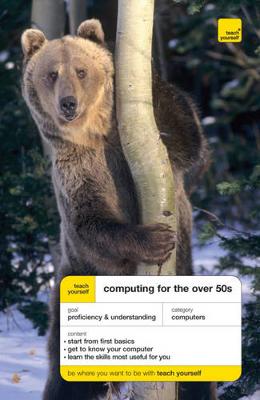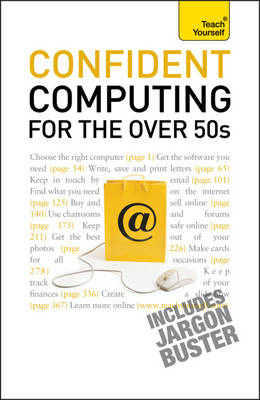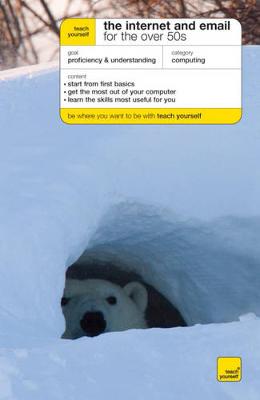Tyco
3 total works
The aim of this book is to provide instructions and advice on a wide range of computer uses for those who feel they have been left behind in the technological revolution, most especially the over 50s. Assuming no prior knowledge of using a computer, it is written in a practical, light-hearted and non-technical style to take the terror out of technology. The author approaches the subject in a highly accessible way, focussing on the computer applications of most interest to middle and third agers, including correspondence, photography, shopping online, personal budgets and researching your family history. Starting from first basics it begins with how to switch on the computer and ends with an invaluable 'jargonbuster' glossary. The book will be made up of a series of self-contained chapters, with the emphasis on what the computer is being used for, rather than the software needed.
For example: rather than a chapter on 'word-processing', there will be a chapter on 'letter writing'; rather than a chapter on 'desktop publishing' there will be chapters on 'making a newsletter' and 'creating invitations'; rather than one on 'digital photography' there will be one on ' getting photographs on to the computer' etc. There will be clear instructions supported with screenshots, tips and hints throughout. This approach will distinguish it from other books on basic computer skills as it covers what the reader wants to do with their computer, breaking down any technical barriers and making the book totally relevant and accessible to the novice computer user.
For example: rather than a chapter on 'word-processing', there will be a chapter on 'letter writing'; rather than a chapter on 'desktop publishing' there will be chapters on 'making a newsletter' and 'creating invitations'; rather than one on 'digital photography' there will be one on ' getting photographs on to the computer' etc. There will be clear instructions supported with screenshots, tips and hints throughout. This approach will distinguish it from other books on basic computer skills as it covers what the reader wants to do with their computer, breaking down any technical barriers and making the book totally relevant and accessible to the novice computer user.
Do you feel that you have been left behind in the technological revolution? Assuming no prior knowledge of using a computer, this book is written in a practical, light-hearted and non-technical style to take the terror out of the technology. Bob Reeves approaches the subject in a highly accessible way, focusing on the computer applications of most interest to middle and third agers, including correspondence, photography, shopping online, personal budgets and researching your family history. It begins with the very basics and ends with an invaluable 'jargonbuster' glossary. The book is made up of a series of self-contained chapters, with the emphasis on what the computer is being used for, rather than the software needed. For example: rather than a chapter on 'word-processing', there is a chapter on 'letter writing'; rather than 'desktop publishing' there is 'making a newsletter' and 'making cards for all occasions'; rather than one on 'digital photography' there is ' getting photographs on to the computer' etc. There will be clear instructions supported with screenshots, tips and hints throughout.
This approach sets it apart from other books on basic computer skills as it covers what you really want to do with your computer, breaking down any technical barriers and making the book totally relevant to the novice computer user. NOT GOT MUCH TIME? One, five and ten-minute introductions to key principles to get you started. AUTHOR INSIGHTS Lots of instant help with common problems and quick tips for success, based on the author's many years of experience. TEST YOURSELF Tests in the book and online to keep track of your progress. EXTEND YOUR KNOWLEDGE Extra online articles at www.teachyourself.com to give you a richer understanding of computing. FIVE THINGS TO REMEMBER Quick refreshers to help you remember the key facts. TRY THIS Innovative exercises illustrate what you've learnt and how to use it.
This approach sets it apart from other books on basic computer skills as it covers what you really want to do with your computer, breaking down any technical barriers and making the book totally relevant to the novice computer user. NOT GOT MUCH TIME? One, five and ten-minute introductions to key principles to get you started. AUTHOR INSIGHTS Lots of instant help with common problems and quick tips for success, based on the author's many years of experience. TEST YOURSELF Tests in the book and online to keep track of your progress. EXTEND YOUR KNOWLEDGE Extra online articles at www.teachyourself.com to give you a richer understanding of computing. FIVE THINGS TO REMEMBER Quick refreshers to help you remember the key facts. TRY THIS Innovative exercises illustrate what you've learnt and how to use it.
Do you feel that you have been left behind in the technological revolution? Are you looking for sound, practical advice on getting the most out of email and the Internet? If so, 'Teach Yourself The Internet and email for the Over 50s' is exactly what you need! Focussing on a wide range of Internet and email uses that are of particular relevance and interest to older computer users and the technologically terrified, including travel, shopping and much more, this book even covers online dating! The author approaches the subject in a highly accessible way, covering emailing, making calls over the Internet, shopping online, banking, setting up a blog and searching online. Starting from first basics, it begins with how to choose the right computer, software and peripherals.
Made up of of self-contained chapters with the emphasis on what the computer is being used for, rather than scary technical stuff about the software needed, this book covers key areas of interest including: getting started with email, sending and receiving emails and attachments; making phone calls over the Internet (VOIP etc), 'chatting' over the Internet, reading and writing 'blogs'; keeping your personal information safe online and keeping your computer safe from viruses; finding what you need on the Internet, shopping, banking and online auctions. Filled with clear instructions and supported with screenshots, tips, hints and a full 'jargon-busting' glossary, it assumes no prior knowledge of using the Internet and email, guiding you with practical good humour to success.
Made up of of self-contained chapters with the emphasis on what the computer is being used for, rather than scary technical stuff about the software needed, this book covers key areas of interest including: getting started with email, sending and receiving emails and attachments; making phone calls over the Internet (VOIP etc), 'chatting' over the Internet, reading and writing 'blogs'; keeping your personal information safe online and keeping your computer safe from viruses; finding what you need on the Internet, shopping, banking and online auctions. Filled with clear instructions and supported with screenshots, tips, hints and a full 'jargon-busting' glossary, it assumes no prior knowledge of using the Internet and email, guiding you with practical good humour to success.


